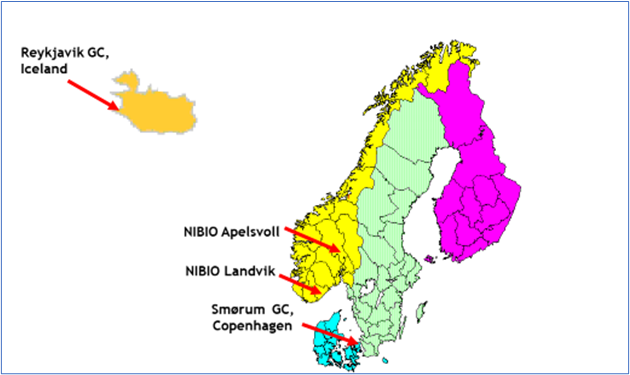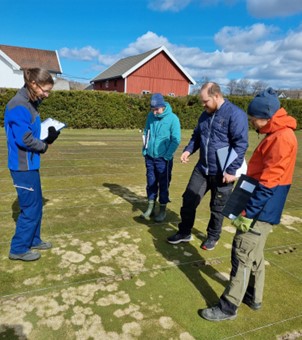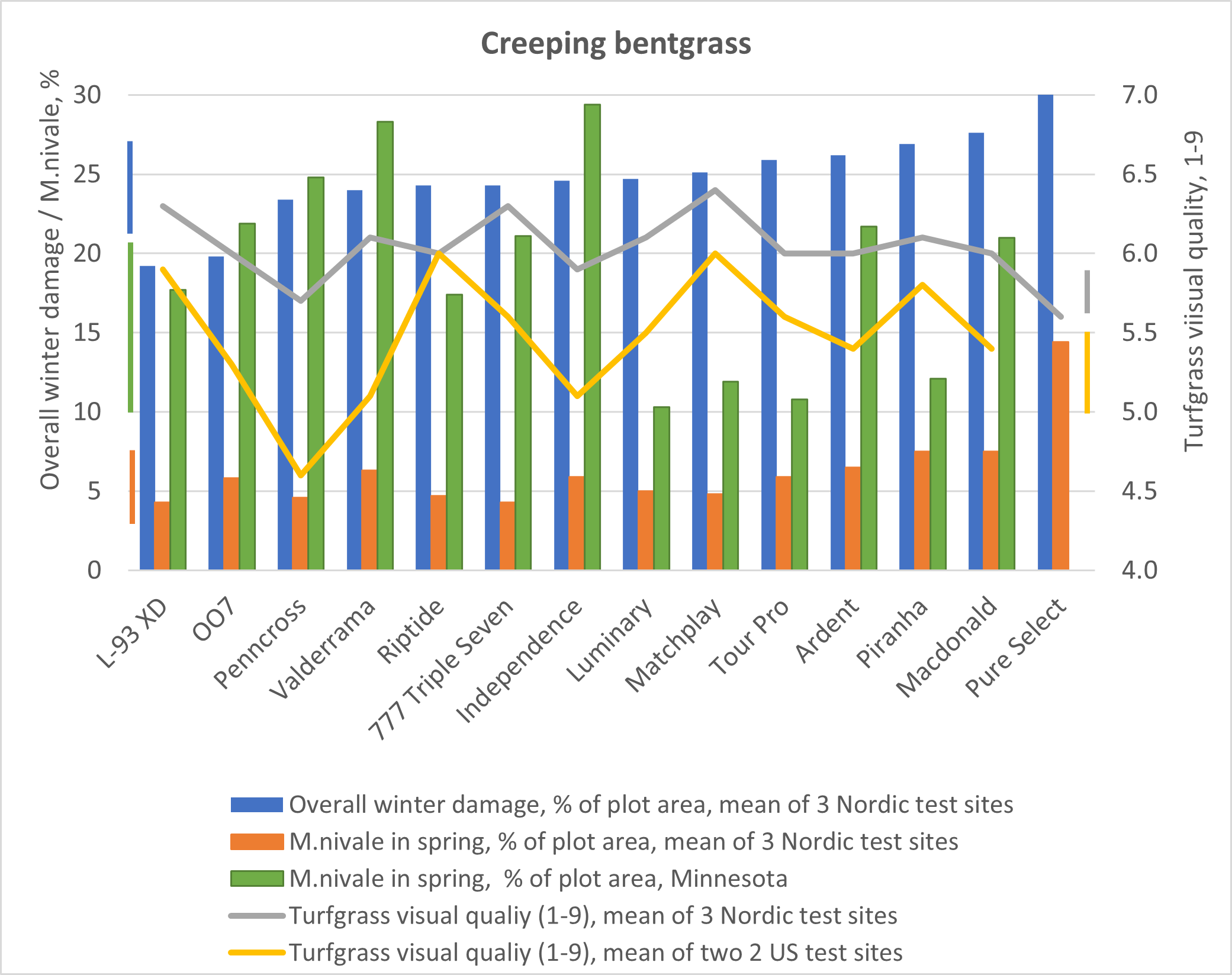By Trygve S. Aamlid, Karin J. Hesselsøe, Anne F. Borchert and Pia Heltoft,
Norwegian Institute of Bioeconomy Research (NIBIO)
The Scandinavian Turfgrass and Environment Research Foundation (STERF)’s SCANGREEN program for variety testing on putting greens is the Nordic equivalent to the National Turfgrass Evaluation Program (NTEP) in North America. Since its initiation in 2003, about 160 varieties, mainly of species creeping bentgrass, colonial bentgrass, Chewings fescue and slender creeping red fescue, have been tested in four-year test cycles under putting green management. The evaluations are conducted without pesticides (including plant growth regulators) and at least three of the four test sites (Reykjavik in Iceland along with Apelsvoll and Landvik, Norway) have tough winter conditions (Figure 1). Results from this program should be of interest for turfgrass managers in the northern US and Canada as well. As part of the WinterTurf project, test sites in Minnesota and Massachusetts were also added to the program in the last test cycle that has now been completed.

Protocols
The test protocols for SCANGREEN, and the corresponding program SCANTURF for variety testing on football pitches and short-cut lawns (15-20 mm mowing height), can be found at www.scanturf.org. In SCANGREEN, creeping bentgrass varieties are compared at a mowing height of 3 mm and a seasonal fertilizer input of 16 g N/m2, fine fescues at 5 mm and 10 g N/m2 and colonial bentgrasses at 3 mm and 10 g N/m2. Except in Minnesota, all trials in the 2019-22 test round were conducted on greens constructed according to USGA-specifications.
The SCANGREEN variety testing includes a number of factors. Here we will focus on overall winter damage, microdochium after snow melt in spring and turfgrass quality (all seasons) in creeping bentgrass, which is the species that probably has the most interest to US superintendents. While microdochium infection is usually assessed one or two days after snow melt, the overall winter damage also includes abiotic injuries and is usually assessed 2-4 weeks later, at turfgrass green-up.

During the three winters from 2019 to 2022, the most severe damage was observed at NIBIO Apelsvoll, about 140 km north of Oslo. Reykjavik GC and NIBIO Landvik also had some damage, notably in spring 2021 (Figure 2). The trial at Smørum GC in Copenhagen was not established until 2021 and will not be included here. The test site at Amherst, Massachusetts reported neither overall winter damage nor microdochium patch, while the test site in Minnesota reported microdochium patch but, not any abiotic damage.
Results and discussion
Mean values for species: The fescue advantage
Like NTEP, SCANGREEN has been set up primarily to rank varieties within a single species. A comparison of mean values for multiple species may nevertheless have some interest, especially when it comes to overall winter damage and microdochium patch. To this end, the summary in Table 1 clearly shows the advantages of fescues at the Nordic, as well as the US, test sites. However, despite these advantages in the early spring, creeping bentgrass was deemed to have the highest turfgrass quality across seasons on both continents.
Table 1. Mean values across varieties within species

Many readers will probably be surprised by the results presented in Table 1 as they are not in agreement with most textbooks’ ranking of turfgrass species for ‘cold hardiness’. Beyond the fact that the SCANGREEN trials are never treated with fungicides, we believe that the winter survival of fescues vs. bents were favored by the overall low input management in these trials.
Creeping bentgrass varieties
Figure 3 shows results for 14 varieties of creeping bentgrass ranked for increasing overall winter damage on average for Reykjavik, Apelsvoll and Landvik. The most winter-hardy variety was ‘L-93XD’, followed by ‘007’. ‘Pure Select’ (not tested at the US sites) seemed to be especially susceptible to both abiotic winter damages and microdochium.

The assessment of microdochium patch at snow melt in Minnesota mostly showed a poor correlation with the corresponding assessments at the three Nordic test sites. The reason for this is unknown, but it can only be speculated that different races of microdochium are present at the various test sites. A similar result was seen in colonial bentgrass, where the US variety ‘Musket’ was the most infected with microdochium patch in the Nordic countries, but the least infected in Minnesota.
The overall scores for turfgrass quality reflected winter damage only to a certain extent. ‘L-93XD’ was ranked second for overall quality, exceeded only by ‘Matchplay’ which was not among the top five when it comes to winter survival. In contrast, the low quality of ‘Pure Select’ at the Nordic test sites clearly reflected its low winter hardiness and susceptibility to microdochium.
New test round to be started 2023
The complete report from SCANGREEN 2019-2022 will be published at www.sterf.org by the end of April. Complete rankings of creeping bentgrass, colonial bentgrass and red fescue cultivars, including those that were tested in previous test rounds, for winter hardiness, microdochium resistance, turfgrass quality and other characters are also available at www.scanturf.org.
A new SCANGREEN test round for the period 2023-2026 is going to be seeded at the same sites except Massachusetts this year. We encourage US breeders and seed companies to enter varieties and breeding lines for a thorough evaluation of tolerance to various winter stresses.
Acknowledgments
NIBIO Turfgrass Research Group would like to thank our collaborators in Denmark, Iceland, Massachusetts and Minnesota for the establishment, maintenance, and assessments in these trials. The Scandinavian Turfgrass and Environment Research Foundation and the University of Minnesota’s WinterTurf project, funded through the USDA Specialty Crop Research Initiative, are gratefully acknowledged for funding this research.